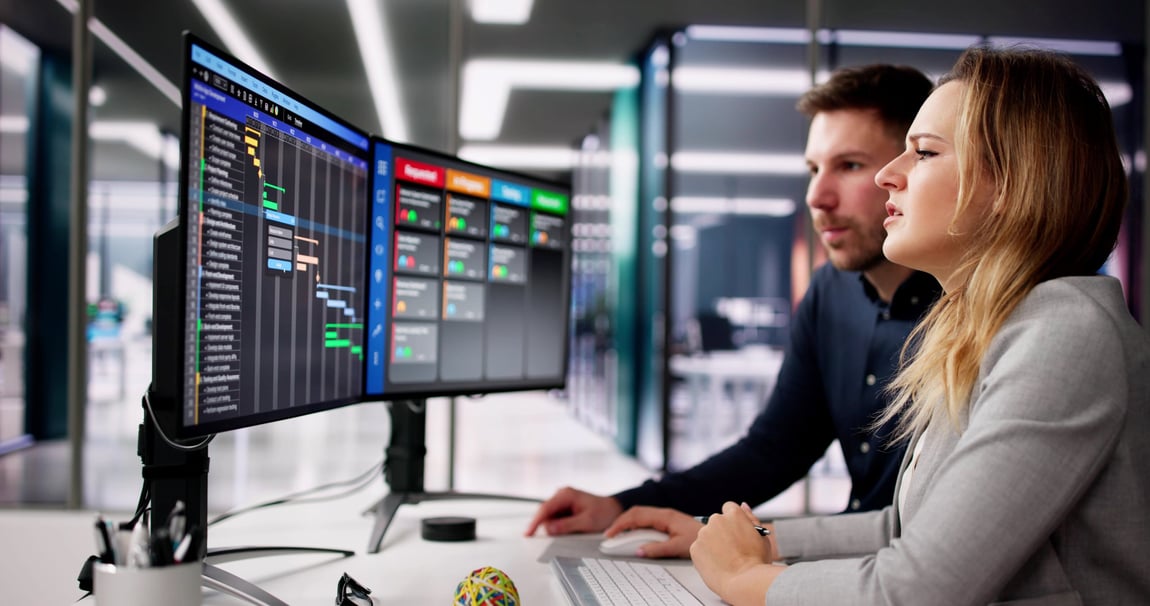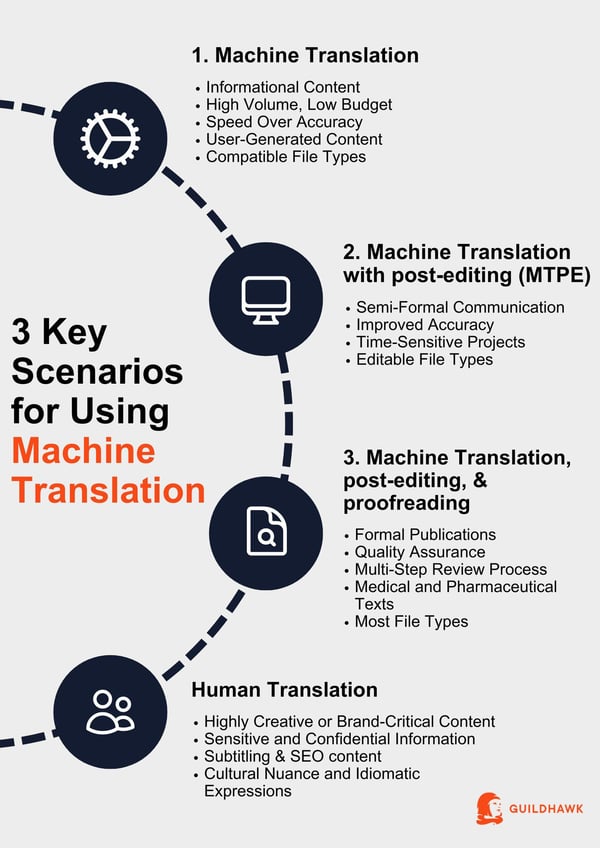
3 Key Scenarios for Using Machine Translation (With Examples)
Machine translation has become an invaluable tool for bridging language barriers, but is it the answer for all your translation needs?
The effectiveness and appropriateness of machine translation can vary significantly depending on the context.
In this article we highlight some of the key factors you should consider when choosing between machine translation and other translation methods.

1. When to use machine translation (MT)
Machine Translation is most suitable in scenarios where speed and cost-efficiency are prioritised over accuracy and nuanced understanding.
Here are some ideal situations for using Machine Translation.
- Informational Content: When the primary goal is to gain a general understanding of the content in a foreign language, such as internal documents, rough drafts, or personal communications.
- High Volume, Low Budget: When there is a large volume of content to be translated and budget constraints do not allow for human translation.
- Speed Over Accuracy: When the content is needed quickly, and the highest level of accuracy is not critical.
- User-Generated Content: For platforms dealing with user comments, reviews, or social media posts, Machine Translation helps to quickly translate large volumes of content to monitor and respond in real-time.
- Compatible File Types: Text files, Word documents, Excel sheets, and other easily editable formats that do not require layout adjustments.
Ever wondered how does Human Translation compare with Machine Translation?
2. When to use machine translation with post-editing (MTPE)
Machine Translation with Post-Editing (MTPE) is a hybrid approach that combines the speed of Machine Translation with the quality enhancement of human editing.
This method is suitable in the following scenarios:
- Semi-Formal Communication: For external communications where the content is not highly sensitive, but accuracy is important, such as emails or newsletters to clients. (MTPE ensures a higher quality translation than MT alone).
- Improved Accuracy: When a higher level of accuracy is required than raw MT output can provide, but the cost of full human translation is prohibitive.
- Time-Sensitive Projects: When the project deadline is tight, but there is a need for better quality than raw machine translation.
- Editable File Types: Editable file types that are supported by your TM platform, allowing for efficient post-editing.
When choosing a machine translation service provider, it is important to check that it uses high-quality, clean data; otherwise you might get results that are inaccurate.
There is a flood of bad machine translations which has a serious impact when training AI models because toxic datasets can cause Large Language Models to generate misinformation and even implode.
Your existing Translation Memories can be leveraged with Guildhawk’s GAI machine translation software, which means that any content segments (usually a short sentence) that have been translated in the past by a human linguist or verified by a proof-reader, will override the generic machine translation, improving accuracy.
3. When to use machine translation, post-editing, and proofreading
For content that demands a high level of accuracy, readability, and stylistic consistency, integrating machine translation with post-editing and proofreading is crucial.
This comprehensive approach is ideal for:
- Formal Publications: For content that will be published or widely distributed, such as marketing materials, technical manuals, or websites.
- Quality Assurance: When the content must be accurate and well-written, reflecting the professionalism of the client.
- Multi-Step Review Process: When a multi-step review process is necessary to ensure the highest quality, including checks for consistency, tone, and style.
- Medical and Pharmaceutical Texts: These translations require an extremely high degree of accuracy due to the potential implications for patient safety and regulatory compliance. Post-editing ensures that medical terminology is correctly translated, while proofreading checks for final errors and consistency.
- Most File Types: Including those that require layout considerations, if they are compatible with your MT platform and proofreading tools.
Important notice
Post editing content that has been machine translated with software other than Guildhawk’s GAI machine translation software, may require additional time due to software compatibility.
Files requiring formatting and/or typesetting in InDesign could be handled with human only or Aided workflows – the additional human input would be needed for the design review at the end.
Find out how to choose the best Machine Translation software in 2024.
When to use only human translation
Despite the advancements in machine translation, certain situations still demand the nuanced understanding and cultural sensitivity that only human translators can provide.
Opt for human translation in these cases:
- Highly Creative or Brand-Critical Content: For marketing campaigns, advertising, slogans, or any content requiring transcreation where the message must be culturally adapted, not just translated.
- Sensitive and Confidential Information: For highly sensitive documents, such as legal contracts and financial reports, human translators ensure confidentiality and precise translation.
- Subtitling and SEO content: These can be subject to character/word count limitations so require a human expert to ensure the translations comply with any such limits.
- Cultural Nuance and Idiomatic Expressions: Content that involves humour, idioms, or cultural references that typically do not translate well with machine translation.
Key takeaways: A powerful tool, not a replacement
Machine translation is a powerful tool, however, it's important to understand its limitations.
For critical documents or content requiring a high degree of accuracy and nuance, human expertise remains irreplaceable.
- The choice between MT, MTPE, MTPE with proofreading, and human translation depends on the nature of the content, required quality level, budget, urgency of the project, and the file types involved.
- By understanding these factors, we can help you select the most appropriate translation method to meet your needs.
- By using machine translation strategically and prioritising post-editing for important content, you can leverage the best of both worlds, ensuring clear and impactful communication across languages.

